Ritz-Carlton Melbourne
Does the tallest hotel in Australia live up to sky-high expectations? Travel + Luxury visited a glittering tower in the billion-dollar West Side Place precinct to find out.
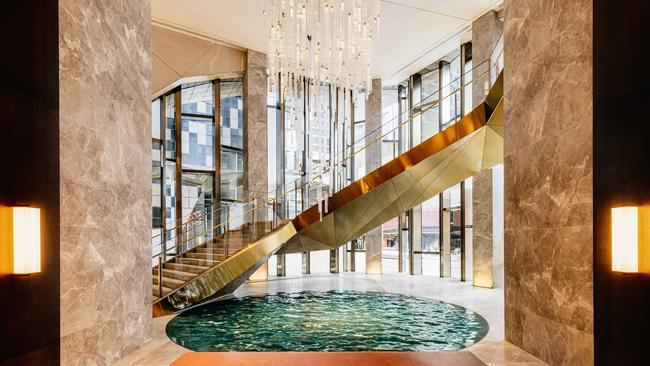
When the Ritz-Carlton Melbourne opens its doors in late March it won’t just be the nation’s tallest hotel – check-in is 80 storeys up – it might also be the most Melbourne hotel yet.
The signs are there from the moment guests enter the street-level lobby. The door handles are a traditional welcome necklace of reeds and feathers made by Indigenous Victorian artist Maree Clarke and cast in bronze. “It’s a very symbolic moment and gesture,” says Rowena Hockin, curatorial director for Melbourne- and Madrid-based design firm Bar Studio. The artwork symbolises welcome, as well as connection to the land of the Kulin nation.
The double-height lobby, meanwhile, blends the polish of a Ritz-Carlton property – dark hardwood timber, a mosaic of marbles including gold-veined calacatta, crystal column chandelier and a blazing wall of gold-leaf – with a mostly Victorian and First Nations art collection. The eye is drawn first to Reko Rennie’s bold, untitled canvas with its neon-bright primaries, pinks and greens, while the face of Bidjara artist Dr Christian Thompson peers out from a collage of flowers. Seven Arnhem Land memorial poles or larrakitj by Dhalwaŋu artist Djirrirra Wunuŋmurra add to the distinct sense of place.
-
Looking to reboot and relax? Discover life-changing wellness retreats and restorative getaways in the latest edition of Travel + Luxury magazine, available online and in print on Friday, 17 February.
-
A monumental, freestanding staircase of faceted brass and marble steps leads to the function floor and Grand Ballroom, which houses a spectacular tribute to the hotel’s hometown. It’s a pity not all guests will experience the ballroom because it’s a sensation. Yes, it has seven-metre ceilings, colossal curtains and a dozen chandeliers, each crafted from 427 pieces of glass by local lighting supremo Mark Douglass. But what commands attention immediately – and for Melburnians will bring a surge of recognition and delight – is the far wall of monochrome glass panels.
It’s an obvious tribute to Leonard French’s stained-glass ceiling at the National Gallery of Victoria, which generations of children (including me) have lain beneath to marvel at its dazzling kaleidoscope of shapes and colours. Here the effect is more subdued, the wall casting a cool alabaster light inside the space. But nevertheless a powerful, joyful jolt of recognition. And so very Melbourne.
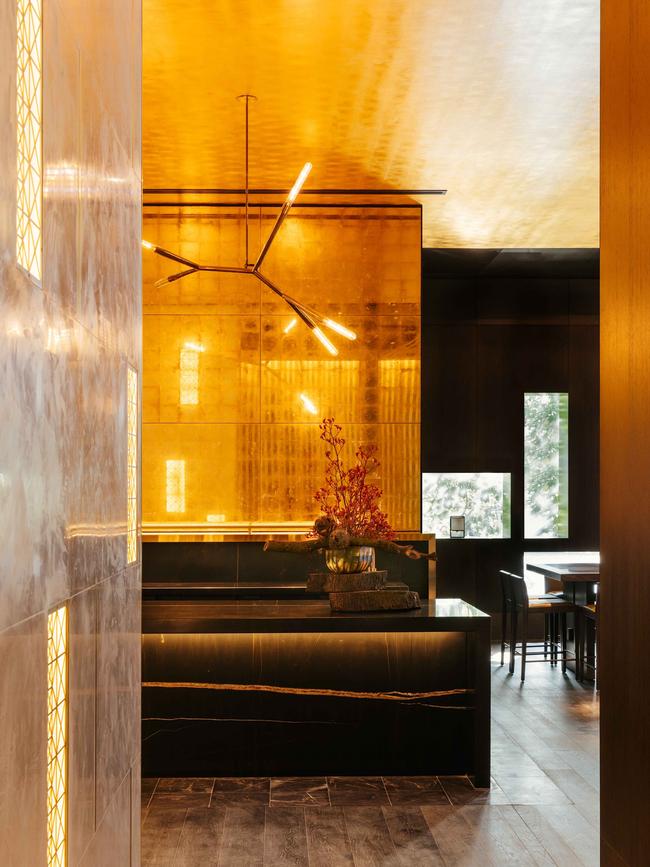

The ballroom’s wonder wall is the most flagrant homage to the city, but there are traces of its DNA everywhere. In the faceting of the staircase, the marble flooring and the tower’s glass exterior, a motif that nods to the contemporary architecture of Federation Square and RMIT’s Storey Hall, among other landmarks. Steel-framed foundry windows channel its industrial heritage; bedside tables assume the shape of bluestone pavers. The herringbone patterning of carpets and fabrics alludes to the bespoke suiting of Collins Street corporates. Nothing, it seems, is incidental.
It’s quite a feat to take a shiny new skyscraper, one of four towers comprising the $2 billion West End Place rebuild of the former Age newspaper site, and infuse it with the character of the Victorian capital. What would – and should – that look like?
“We responded with thinking about what makes Melbourne tick,” says Hockin. “What the hotel could possibly pay tribute to, bringing in some of the ideas of Melbourne icons. Things like the Great Hall at the NGV … Melbourne as a literature city (it’s been a Unesco City of Literature since 2008). Those grand boulevard streets, the plane trees and the amazing classical architecture … that establishment and very refined sense of the city, but then you’ve got the contrast with the laneways that cut through it.”
All these ideas and more were contained in an original “thematic statement” presented by Bar Studio to developers Far East Consortium (also behind Queens Wharf Brisbane and Elizabeth Quay in Perth) back in 2015. It was adopted enthusiastically. The hotel occupies levels one and two and then 64 to 80, with posh apartments occupying the floors in between. The challenge for Bar Studio was to connect the ground and the gods, the street level with the Sky Lobby.
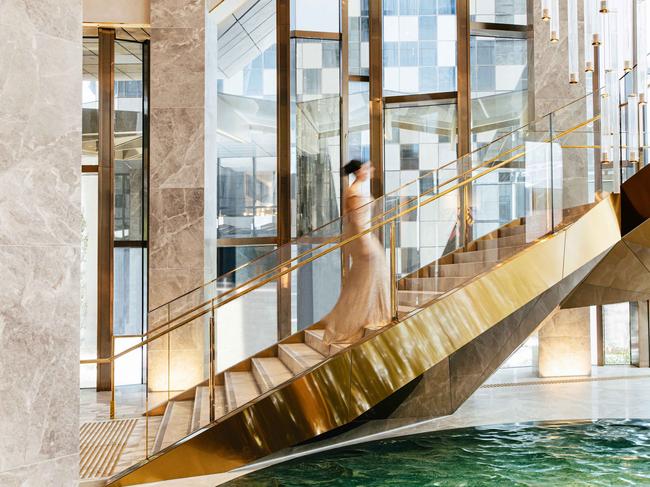
Arriving guests are greeted by the Ritz-Carlton’s concierge team and escorted up to the 80th floor via express lifts, each fitted with a constellation-patterned mirror work by artist Andrew Taylor, a harbinger of what lies ahead. En route, there’s much to discover.
Level 64 is home to the hotel’s remarkable pool, an 18-metre infinity arrangement flanked by platform daybeds capturing soaring, infinite views out to the bay and beyond to Point Nepean and Queenscliff, the Dandenong Ranges and Mount Macedon. The pool connects to a six-room spa via a vertical cascade, an allusion to the NGV’s famous entrance but also to the former waterwall at the city square that was often plastered with plane-tree leaves by passers-by. Hence the bronze-cast leaves adorning the veil of water here.
And there are the rooms themselves, 257 of them off windowless corridors so that when guests open their doors they’re hit by the full, luminous impact of the aerial cityscape. The views do much of the heavy lifting in terms of wow factor, but room interiors are every bit as thoughtful and considered as the rest of the hotel.
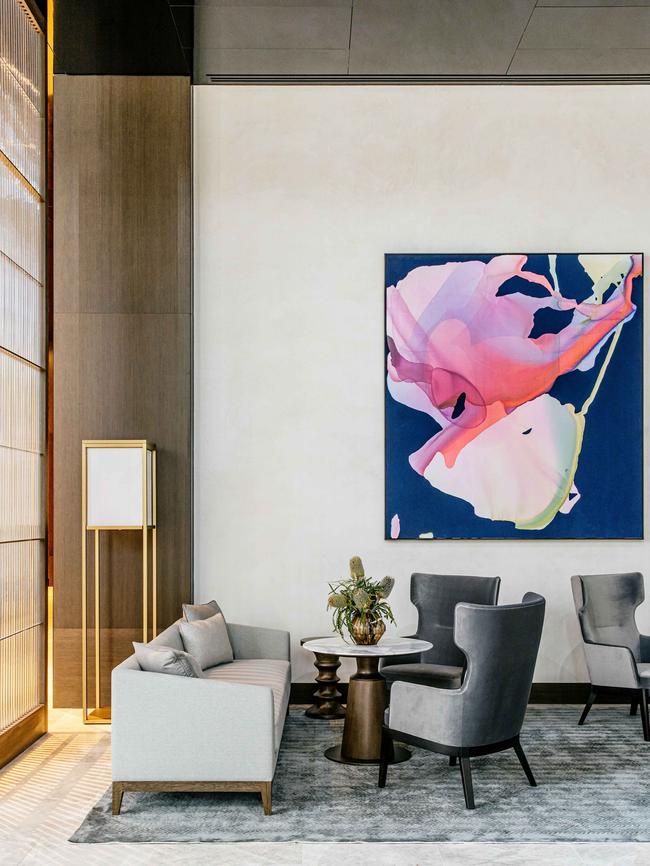
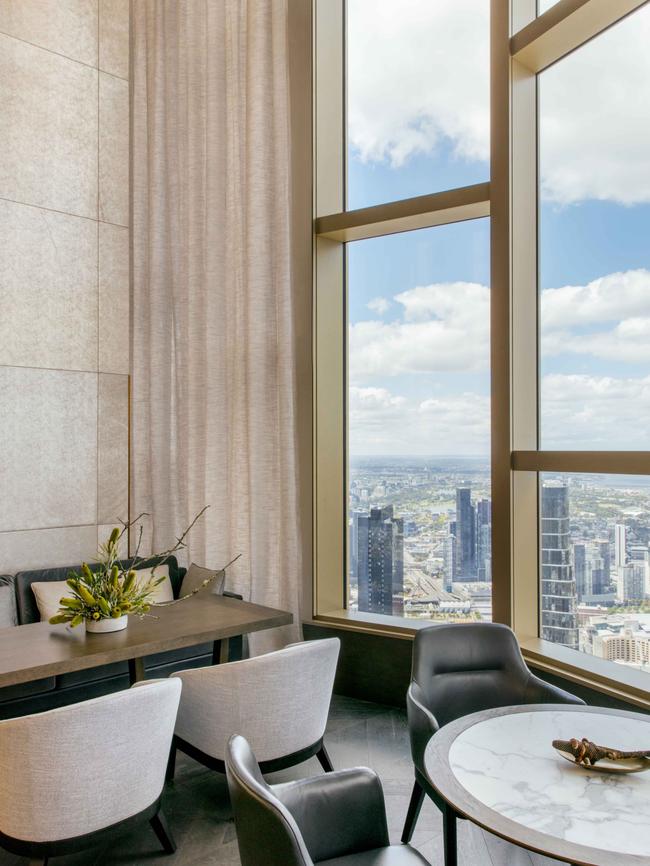
Entry-level accommodation is 46 square metres, among the city’s largest, increasing incrementally to the 251-square-metre Ritz-Carlton Suite on level 79. The vibe is “residential, homely”, in Hockin’s words – an accurate description if your home is as richly textured in velvet armchairs, herringbone carpets and daybeds, marble-trimmed bathrooms and leather headboards the colour of manzanilla olives. Every room has a proper dining table, belted with marble, paired with timber and leather chairs. Bedlinens and towels are Frette; amenities are Diptyque. Crosshatched panels in the bathroom can slide across for privacy or stay open for panoramic bathing.
The Melbourne moments are there in the bookshelves and superior reading selection (Margaret Atwood, Salman Rushdie), and the inset glass tiles to lend “that element of surprise and detail – and craftsmanship – that are such a part of the city”, says Hockin. In the contemporary art: oversized black-and-white laneway and landmark prints by photographer Fabrice Bigot, prints by Corinna Berndt and sketches by Robert Scholten, whose street-style paste-ups also adorn lift lobbies. And in the dark timber and soft lighting that create a “slightly clubby” feel – clubs being a particularly Melbourne obsession.
The Sky Lobby on level 80 is the showstopper. Australia’s most breathtaking check-in. But, like Melbourne itself, not all is revealed at first sight. Guests arrive to find a glass-panelled screen, a peekaboo wall with some panels frosted or rippled for tantalising glimpses to the outlook beyond – parklands, skyscrapers, suburbia, sea. Behind it is the The Ritz-Carlton Lounge, the destination for all-day dining, brunch and lunch, coffee. High tea will be a highlight, as will sunset drinks in the velvety west-facing bar with direct sightlines over the Bolte Bridge to the industrial architecture of the west.
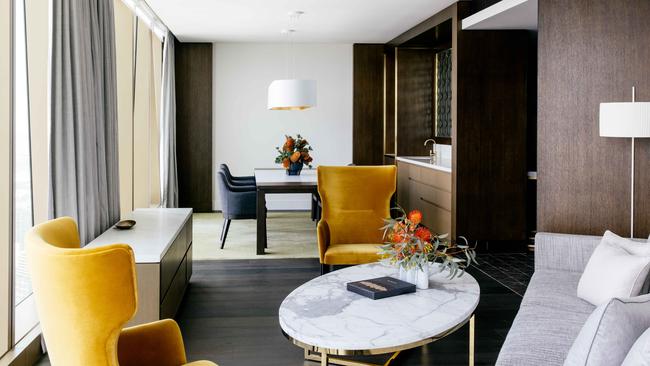
Level 80 is also the location of the Ritz-Carlton’s stunning restaurant, Atria. This is dining as high-altitude theatre. A tessellated-tiled entrance (reminiscent of the porch of a Victorian terrace), with a wall of wine and mother-of-pearl bar one side, and a glass-walled pastry kitchen on the other, leads to a glass observatory floating above the five million- strong city. The menu at Atria – the name references a giant orange star in the constellation Triangulum Australe, the Southern Triangle, visible here at night – had not been revealed at the time of writing. But pulley-operated grills and pasta extruders in the show kitchen give some hints of the direction.
As well, a 38-seat timber bar wrought from a single Victorian ash tree (harvested sustainably from the Dandenongs) suggests snacks and share plates, inventive drinks and chef interactions. Served with views north across the metropolis.
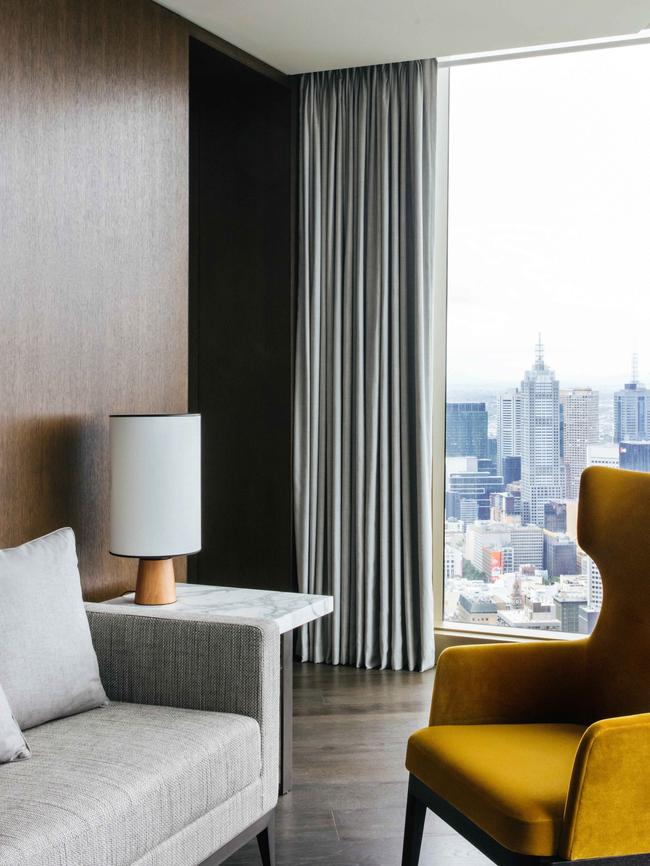
Executive chef Michael Greenlaw is, fittingly, ex-Vue de Monde, for decades the capital’s loftiest fine-diner. With Michelin-starred stints at London’s Bibendum and Gilt in New York, he’ll be looking to exceed expectations here. “Our vision is driven by a quest for the unusual, the hard to find and the hyper-seasonal,” Greenlaw says. In that he’ll be ably assisted by mentor Mark Best, one of Australia’s most celebrated chefs, who’s come on board as culinary advisor.
“Michael and I just love the fact you can look out the windows and see where the food on your plate is sourced – from the Macedon Ranges in the west to the Dandenongs to the east, and Port Phillip Bay stretching out in front of you,” Best says. “It gives a deep sense of connection and that sense of place that sits at the heart of what the Ritz-Carlton Melbourne is all about.”
Melbourne’s top hotels have traditionally been at the east or “Paris” end of the city. This is the fifth hotel opened in the southern CBD by parent company Marriott Bonvoy (including the Docklands Marriott and the W) in the past couple of years. In addition there’s been a slew of new luxury accommodation openings since 2020. How will the Ritz-Carlton compete?
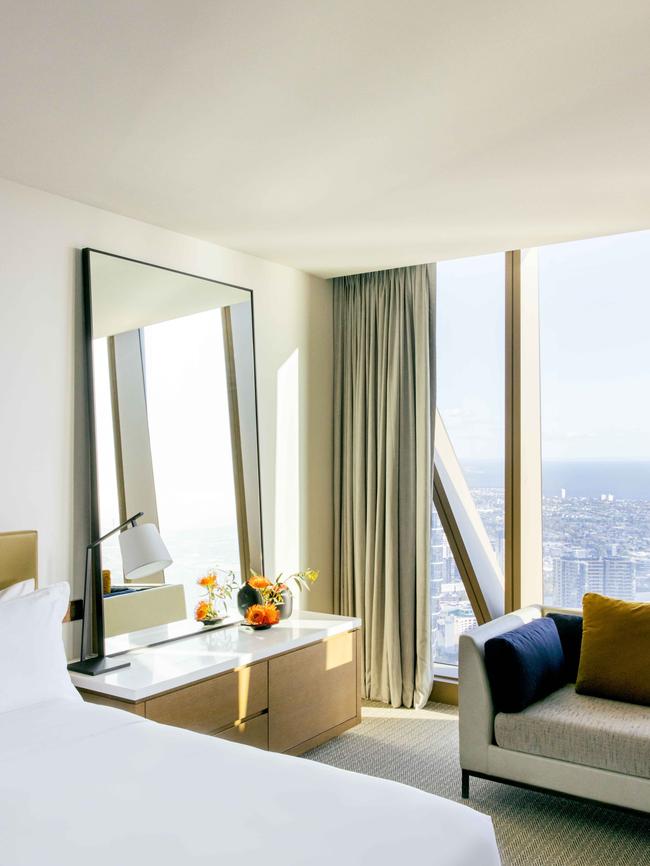
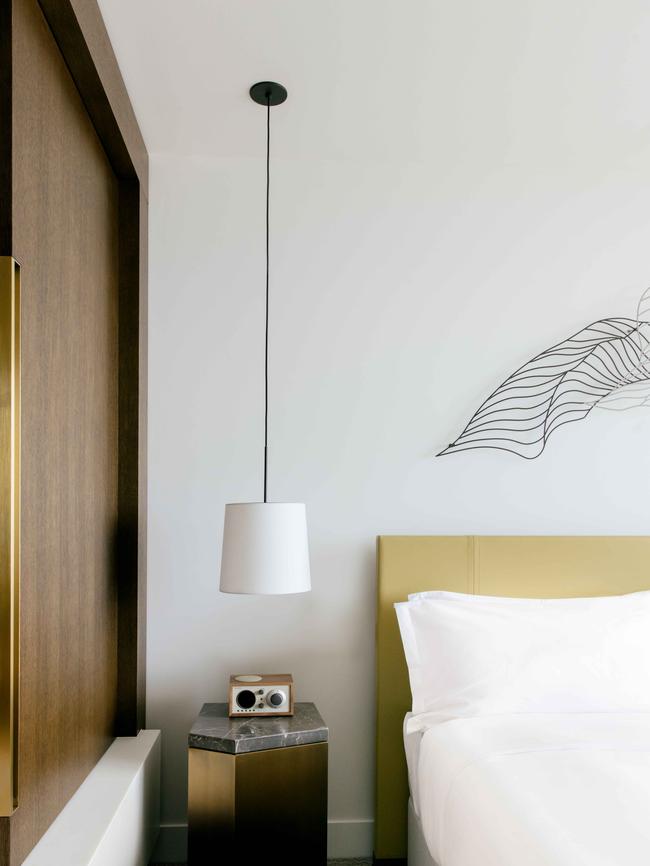
“Every single hotel’s got marble and carpet and lovely artwork and shiny toys,” says general manager Antony Page. “But it’s that service attention to detail, that emotional engagement, and providing genuine care and comfort” that will set them apart.
The Ritz-Carlton will, he assures me, have a higher staff-to-guest ratio than any other hotel in town.
“It’s very much a case of making sure that we are elevating ourselves,” he smiles. Which, given the circumstances, shouldn’t be too hard at all.
The Ritz-Carlton Melbourne opens in late March. Room rates from $615 a night. 650 Lonsdale Street, Melbourne.
Looking to reboot and relax? Discover life-changing wellness retreats and restorative getaways in the latest edition of Travel + Luxury magazine.

To join the conversation, please log in. Don't have an account? Register
Join the conversation, you are commenting as Logout